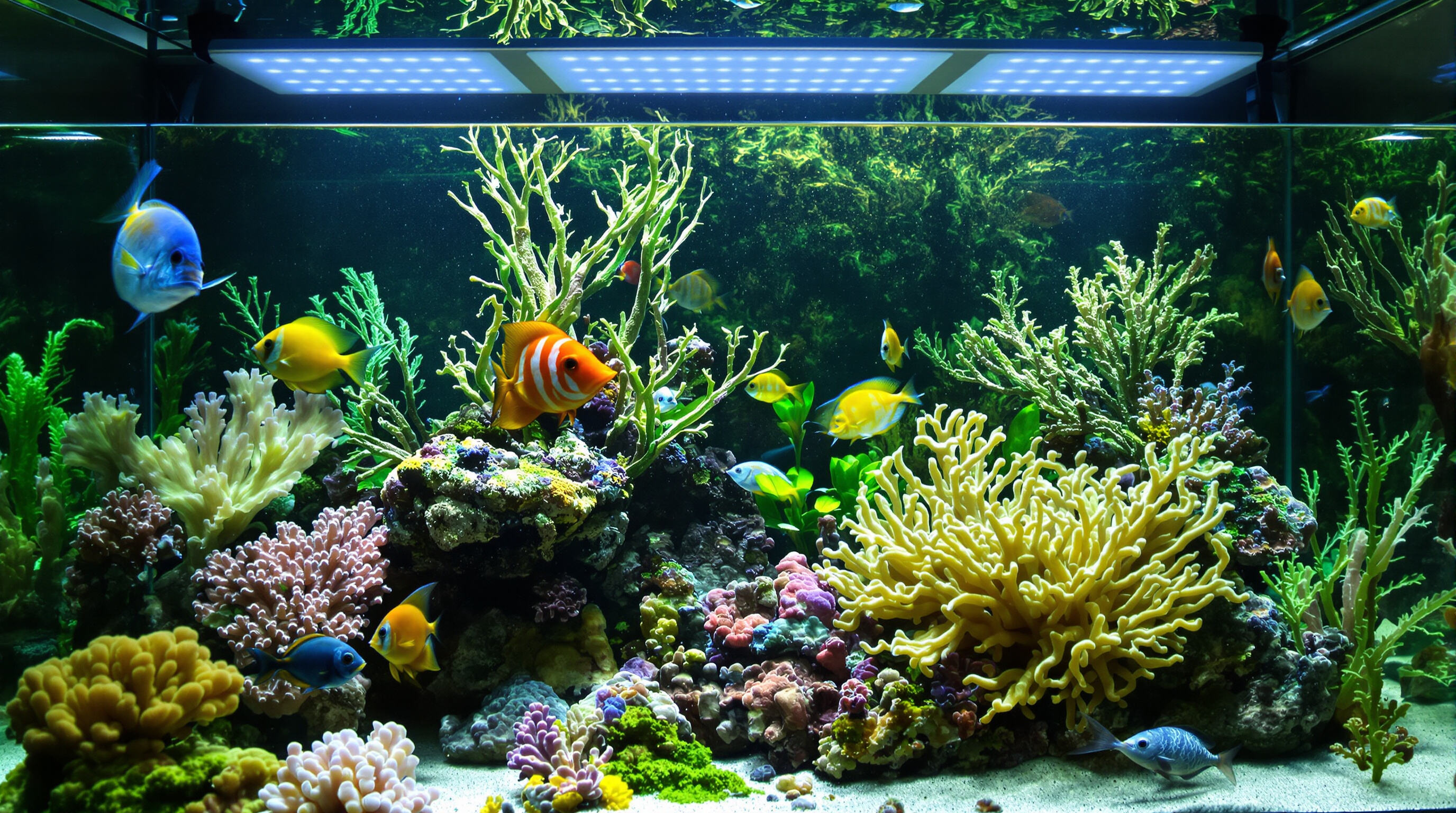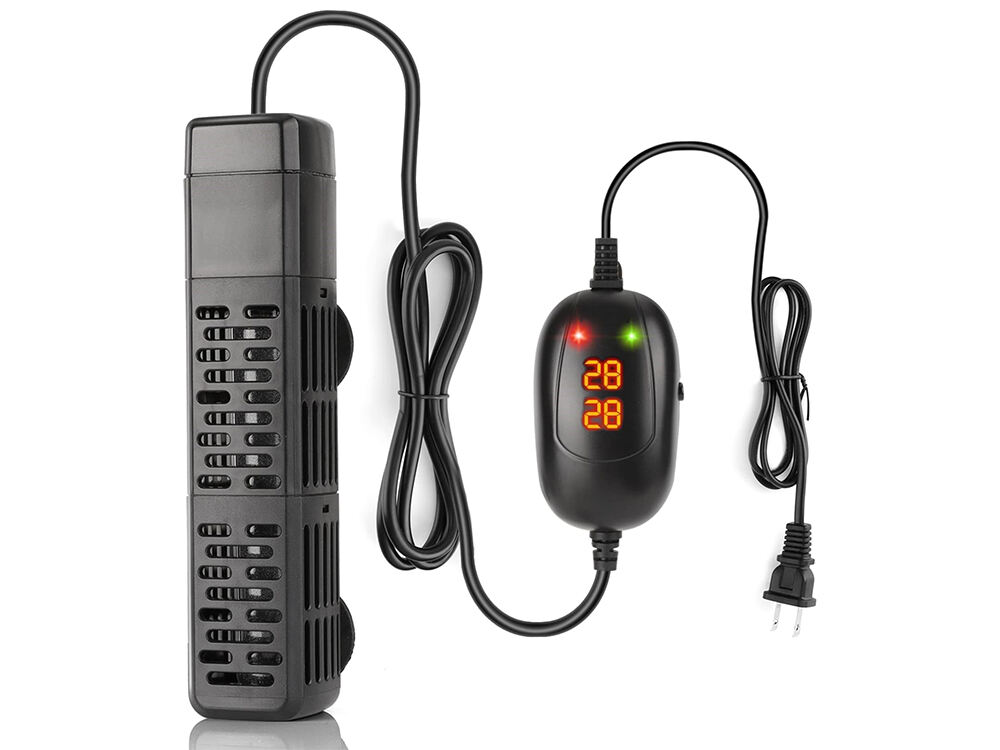Understanding Color Rendering and CRI in LED Aquarium Lights
What is CRI (Color Rendering Index) and why it matters for led aquarium light performance
The Color Rendering Index, or CRI for short, basically tells us how well a light shows off real colors when compared to good old sunlight. When it comes to lighting tanks, getting something with a CRI score over 90 makes all the difference. Fish scales look brighter, corals glow properly, and those plants just pop with their natural colors. Tests show that these high quality LED lights cut down on color warping by around 34 percent compared to cheaper options with lower CRI ratings. This matters a lot when trying to tell apart similar looking fish or spot health issues in delicate corals like Acropora species.
How light spectrum influences color accuracy and visual clarity in aquatic environments
LED lights emitting a 450—660 nm spectral range closely mimic natural underwater light penetration, enhancing both color accuracy and depth perception. Full-spectrum LEDs excel in freshwater and reef tanks by balancing:
- Blue wavelengths (450—495 nm) for coral fluorescence
- Red wavelengths (620—750 nm) to amplify fish pigmentation
This spectral precision reduces "washed out" colors by 22% in plant-heavy aquascapes.
The relationship between LED color temperature and perceived fish and plant vibrancy
Color temperature (measured in Kelvin) directly impacts visual appeal:
| Kelvin Range | Visual Effect | Biological Impact |
|---|---|---|
| 5000K—7000K | Enhances green plant foliage | Supports photosynthesis |
| 10000K+ | Intensifies blue coral hues | Mimics shallow reef sunlight |
Systems with adjustable 6500K daylight settings increased perceived fish vibrancy by 19% in community tanks.
How LED Light Spectrum Enhances Aquatic Life Coloration
Impact of red, blue, and green wavelengths on fish pigmentation and coral fluorescence
Aquarium LED lighting works by using certain colors of light to bring out the natural colors in aquatic life. The red part of the spectrum, which ranges from about 620 to 750 nanometers, really brings out those carotenoid pigments in fish. This makes the yellow and orange tones stand out more in species such as discus and guppies. When it comes to corals, blue light between 450 and 495 nm actually makes them glow because it activates their fluorescent proteins. Some tests have found that corals look around 30% more vibrant when exposed to light at around 465 nm specifically. Green light covering wavelengths from 495 to 570 nm helps showcase plants without making algae grow too fast, giving tanks that nice layered look that hobbyists love so much.
Role of specific LED spectra in promoting natural color expression in freshwater and marine species
For freshwater tanks, those 6500K white LED lights work wonders because they mix red and blue light wavelengths that mimic natural daylight conditions. This helps trigger the special reflective cells called iridophores in betta fish, making their colors pop. When it comes to saltwater aquariums, most hobbyists go for those actinic blue LEDs between 420 and 480 nanometers since they really bring out the vibrant colors of the symbiotic algae living on coral surfaces. Some newer tunable lighting systems let folks adjust the spectrum by around 15 to 20 percent, which studies have shown can cut down on color loss caused by stress in clownfish populations by nearly half during lab tests. Pretty impressive stuff when considering how sensitive these little guys are to their environment.
Scientific basis for spectral tuning in supporting biological and aesthetic needs
Tuning light spectra to match what corals need for photosynthesis also happens to work pretty well for our eyes too. Studies indicate that around a 7 to 3 ratio of blue to red light seems best for keeping those tiny algae partners healthy inside coral tissues while still looking good underwater. Most folks who run reef tanks report liking this balance, though I've heard some hobbyists argue about exact numbers since everyone perceives colors differently anyway. The bonus here is that this balanced lighting approach stops the problem called overlighting which causes about a quarter of all algae issues when aquarium lights are set up wrong. Reef keepers know from experience that getting this right makes a world of difference in maintaining healthy ecosystems without turning their tanks into green soup factories.
Adjustable Spectrum and RGB Customization in LED Aquarium Lighting
Benefits of Tunable Color Spectrum for Dynamic Visual Effects with LED Aquarium Light Systems
LED aquarium lights have really changed the game for fish tank enthusiasts who want to make their tanks look amazing. These lights come with adjustable color settings so people can tweak the red, green, and blue channels to get all sorts of cool effects. Some setups let users simulate sunrise and sunset or create soft moonlight looks across the tank. The ability to play around with colors makes corals stand out in saltwater tanks and brings out the vibrant colors in freshwater fish too. Better yet, many high end models now include preset programs that recreate different environments, from shallow tropical waters to those dark Amazonian rivers. Plus, despite all these fancy features, most modern LED systems still manage to save energy compared to older lighting options.
Balancing RGB Customization with Ecological Authenticity: When Aesthetics Support Biology
RGB customization definitely opens up all sorts of creative options, but we need to make sure our color picks actually work with what nature needs. The best reef lighting systems these days come with built-in timers that keep things on track for natural day cycles around 6 to 10 hours of that 6,500K white light stuff, saving the rainbow effects for just little touches here and there. Take blue light for instance - short bursts really help corals extend their polyps without messing up photosynthesis processes. And those soft red tones? They make a big difference when feeding time comes around, letting us see those skittish fish better. Some research from last year showed something interesting too. Tanks that mixed about 85% regular spectrum lighting with only 15% RGB colors grew plants about 22% faster compared to tanks going full rainbow mode all the time. Makes sense when you think about it.
Potential Drawbacks of Overusing RGB Modes Versus Maintaining Natural Daylight Cycles
Putting too much faith in RGB lighting can really mess up tank ecosystems. When colors stay saturated over 30% intensity for long periods, sensitive creatures like cardinal tetras and dwarf shrimp start showing signs of stress. Fish also get confused when their day-night cycles aren't respected through erratic lighting patterns. Tanks that run RGB lights all day every day tend to see about 40% more algae problems than ones that follow nature's rhythm. To keep things balanced, most aquarists find that sticking with full spectrum lighting handles the essential biological needs better. Save those colorful RGB displays for short bursts, maybe around three hours max each day. They work great for showcasing tank decorations during evening hours or creating special visual effects without harming the aquatic life.
Full Spectrum vs. RGB LED Lights: Functionality, Growth, and Visual Appeal
Comparing Full-Spectrum and RGB-LED Aquarium Lights for Balanced Growth and Color Rendering
Aquarium lights that cover the full spectrum of natural daylight do a pretty good job replicating what we see outside, with around 95 percent color rendering index accuracy so colors look more real than most alternatives. The best part about these lights is how they help plants and corals grow through those important blue wavelengths at 450 nanometers and red ones around 660 nm, plus they keep things running on a regular schedule similar to day/night cycles. RGB LED options let folks tweak colors to make certain features stand out in their tanks, whether it's highlighting bright orange clownfish or vibrant purple corals. But when looking at actual results from tank comparisons, full spectrum lighting tends to win hands down. Reef tanks equipped with this type of lighting saw corals growing about 30 percent faster over time because the light covers all the necessary wavelengths properly.
When to Choose Full-Spectrum LEDs for Plant Health and Stable Ecosystems
When setting up those heavily planted freshwater setups or mixed reef tanks, going with full spectrum LED lighting makes a real difference. These lights cover a wider range of wavelengths that match where plants absorb light best around 430 and 660 nanometers. This actually boosts how well plants can photosynthesize, giving them about 20% better efficiency than regular white LEDs. What's great about these lights is they keep the PAR and PUR levels steady throughout the tank, which matters a lot for sensitive LPS corals and tricky plants such as Rotala macrandra. Some tests done last year showed something interesting too. Tanks with full spectrum LEDs had roughly 40% less algae problems compared to ones lit with RGB systems. Turns out those color changing modes tend to create conditions that encourage unwanted algae growth because the light spectrum gets all messed up.
Situational Use of RGB Lighting for Accentuation Without Compromising Biological Integrity
RGB LED aquarium lights shine in display-focused setups where visual impact takes priority. Use these systems to:
- Highlight iridescent scales in Paracheirodon innesi (neon tetras) using targeted 470 nm blue
- Create dawn/dusk transitions with 660 nm red channels
- Accent coral fluorescence during evening viewing sessions
Always pair RGB modes with a base full-spectrum schedule to maintain photoperiod consistency. Limit color-shifting effects to ≤4 hours daily to avoid disorienting nocturnal species, and ensure 80%+ of total daily light energy comes from growth-optimized spectrums.
Optimizing LED Intensity and Spectral Range for Aesthetic and Biological Balance

Modern LED aquarium light systems allow precise control over intensity and spectral output, enabling hobbyists to tailor illumination for both visual appeal and biological needs. Proper calibration ensures vibrant coloration in fish and corals while supporting photosynthesis and ecosystem stability.
Matching Light Intensity and Spectrum to Tank Type: Planted Tanks, Reefs, and Community Setups
Planted freshwater tanks thrive under 6500K white LEDs with less than 20 PAR (Photosynthetically Active Radiation) for low-light species, while reef systems require 400—550 nm blue peaks to stimulate coral zooxanthellae. Community tanks benefit from adjustable 4500—7500K white blends that accommodate mixed species without promoting algae.
Managing Algae Control While Maximizing Color Vibrancy Through Intelligent LED Output
Reducing intensity to less than 50% during midday peaks and emphasizing 500—600 nm green-yellow wavelengths limits nuisance algae growth by 33% while maintaining fish-scale iridescence. Timed dawn/dusk transitions mimic natural environments, reducing stress-induced color fading.
Case Study: Visual and Biological Transformation Using Programmable LED Aquarium Light Systems
A six-month controlled trial demonstrated that tanks using programmable full-spectrum LEDs saw 40% faster coral growth rates and 27% greater chromophore expression in wrasses compared to fixed-RGB systems. Nighttime moonlight modes preserved nocturnal behaviors without disrupting circadian rhythms.
FAQ
What is CRI and why is it important in LED aquarium lighting?
CRI, or Color Rendering Index, measures how accurately a light source reveals the true colors of objects compared to natural sunlight. A higher CRI, typically over 90, ensures brighter and more vibrant colors in fish, corals, and plants. This accuracy is crucial for monitoring the health and vitality of aquarium inhabitants.
How does the light spectrum affect aquatic environments?
The light spectrum, notably the range between 450—660 nm, mimics natural underwater light, improving color accuracy and depth perception. Balancing blue and red wavelengths enhances coral fluorescence and fish pigmentation, while full-spectrum LEDs offer optimal lighting for both freshwater and marine environments.
Why is color temperature important in aquarium lighting?
Color temperature, measured in Kelvin, impacts the visual and biological aspects of an aquarium. For instance, 5000K—7000K enhances plant foliage and supports photosynthesis, while 10000K+ intensifies blue hues in corals. Adjusting color temperature can boost perceived vibrancy in an aquarium.
Table of Contents
- Understanding Color Rendering and CRI in LED Aquarium Lights
- How LED Light Spectrum Enhances Aquatic Life Coloration
- Adjustable Spectrum and RGB Customization in LED Aquarium Lighting
- Full Spectrum vs. RGB LED Lights: Functionality, Growth, and Visual Appeal
- Comparing Full-Spectrum and RGB-LED Aquarium Lights for Balanced Growth and Color Rendering
- When to Choose Full-Spectrum LEDs for Plant Health and Stable Ecosystems
- Situational Use of RGB Lighting for Accentuation Without Compromising Biological Integrity
- Optimizing LED Intensity and Spectral Range for Aesthetic and Biological Balance
- FAQ










